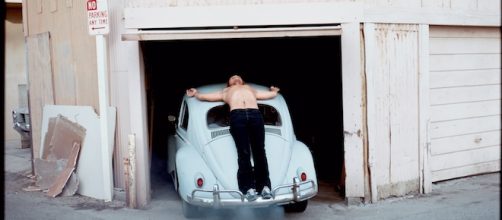Many know artist Chris Burden from his iconic masterwork, “Urban Light,” which consists of 202 restored cast iron antique street lamps adorning the entrance of the Los Angeles County Museum of Art. But unless you’re a student of art, you may be unaware of how Burden’s earlier works pushed the envelope of performance-based art in unusual and dangerous ways. Luckily for fans, directors Timothy Marrinan and Richard Dewey’s new documentary “Burden” presents an in-depth look at the artist from his art school days in the 1970s to his last work before his untimely death in 2014.
Burden’s early art student days
Against the tumult of the Vietnam War, artists in the 1970s began to experiment with the medium, especially on the West Coast. Burden was an early adapter of those that mixed art and performance. From his graduate student days at the University of California Irvine and onwards, Burden immediately began to make a name for himself with works that pushed the envelope.
Buzzy artworks provoke
As “Burden” showcases through its fine use of archival video, photographs and interviews, the young artist quickly set the 1970s art scene on fire. The film examines his UC Irvine work “5-Day Locker,” where Burden contorted his body to fit into a locker for five days. His buzzy, “Shoot,” chronicled Burden literally being shot in the arm with a rifle.
And “Trans-Fixed” displayed Burden laying face up, arms outstretched on a VW Beetle, with his hands nailed as if crucified. It's no surprise that these works (as well as other mind-bending pieces) landed him in magazines and television interviews. A particularly fun interview clip is with a young, dumbfounded Regis Philbin discussing “Shoot” with the artist.
Burden’s sculptures and engineered works
Burden notes in the film that he first wanted to be an architect, but didn’t want to get stuck behind a desk designing routine pieces. And as for sculpture, one of his professors noted that professionally going into that field would be like suicide. But in his later works, Burden moved away from performance and utilized his talents in architecture, engineering and sculpture.
He also bought land up Topanga Canyon and created a workshop where he would test and assemble works, many of which he created on spec.
Burden’s final pieces
It’s from his Topanga Canyon workshop that Burden often talks to the filmmakers about his life and works, including the later, “Urban Light,” “Metropolis II,” and his last piece, “Ode to Santos Dumont.” During the film’s production, the directors learned of Burden’s cancer and untimely death. Thankfully, for both longtime followers and new fans of his amazing work, the insightful documentary “Burden” is able to further illuminate Burden’s intriguing life and works.
“Burden” is Not Rated, 90 minutes, and playing in Los Angeles at the Landmark Quart Theatre, as well as being available On Demand, through Amazon Video, and on iTunes.


